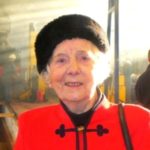Dorothy Mather

Anyone who attended earlier A1SLT Annual Conventions would have seen the diminutive figure of the A1 Trust’s President, Mrs Dorothy Mather, but they might have wondered about her connection with the A1. Her father was a hydraulic engineer with the LNER and she was an only child, born Dorothy Patricia Louch. She grew up in a railway family and naturally every holiday began and ended with a train journey. They lived in a village near Doncaster and she went to private schools. Life was uneventful until her father died, aged only 49.
When the Second World War began, she helped provide refreshments for the many military convoys that stopped in Doncaster at all times of the day and night. Like the other volunteers, she paid a weekly subscription towards the cost of the soldiers’ food and drink, as well as giving her time. That traffic had begun to slacken when she was invited to lunch one Saturday by her best friend, whose father was chairman of the regional coal board. When he found that she was not working, he invited her to come and fill one of their vacancies. Dorothy went home to tell her mother that she had got her first job, at the coal board office in an old manor house at Warmsworth. She rose to become Assistant Surveyor.
With that experience behind her, she moved to Doncaster Works drawing office. Long before this, though, she had already met Arthur Peppercorn socially. He was an able and engaging man who had every quality needed to reach the top, except for self-advertisement. Despite this, he succeeded Edward Thompson as Chief Mechanical Engineer of the LNER on 1st July 1946. He was an effective but considerate boss who never raised his voice or swore. With their great sense of fun, he and Dorothy had soon hit it off, and they eventually married in 1948. Within weeks, the family doctor took her aside to say she should prepare for the worst, “Arthur’s heart might give out at any time. I don’t want to tell him, he’s got enough on his plate.” The post of CME was stressful anyway, even without the turbulence caused by nationalisation. By this time, the Peppercorn A2s and two A1s were already in traffic.
For two and a half years years Dorothy lived with the knowledge that her husband might die at any time. They were both very busy, attended railway occasions together and visited his family in Herefordshire; Arthur had several brothers and sisters. Leaving the Eastern Region of BR in good shape, Arthur retired at the end of 1949, much loved and admired, only to die prematurely in 1951.
After the joy of being married to Arthur, life was bound to seem empty. Still, Dorothy pressed on with life. A few years later, through a friend she met Colonel W H Mather, OBE, TD and ex-LNER. In due course they married, bought a country house near Stokesley and settled down. As Bill’s health failed, they moved to a more modern house and Dorothy nursed him. He died and she became a widow again, but now with an even larger circle of friends. She became a byword for a busy life among Bill’s many nieces and nephews.
In August 1993, David Champion wrote to Dorothy to suggest a meeting at which he could explain to her all about the A1 Project. She was sufficiently impressed to join us informally and from there her involvement grew. She was there at BSD Leeds on 13 July 1994 to start the CNC machine that cut Tornado’s frameplates, at the Trust’s first convention that September and at Tyseley in December for the ceremony marking erection of the frameplates under the supervision of Bob Meanley. She attended every major A1 Trust occasion since then, always immaculately dressed, always interested, kind and courteous to everyone she met. In September 1995 she became joint vice president, later president. Not just a figurehead, she did a tremendous job for the Trust in countless interviews with press and television. She proved quite as vital as our ISO 9000 quality standard because, if Tornado was good enough for her, it would be good enough for Arthur Peppercorn. Sadly Dorothy passed away on the 10th November 2015 and the Trust lost one of its greatest friends.